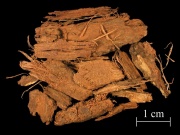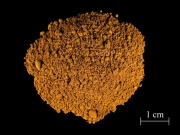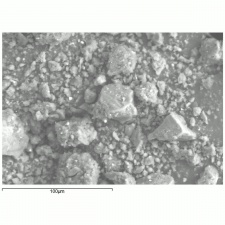Quercitron
Description
A yellow vegetable dye extracted from the black or dark brown bark of the black oak, Quercus velutina (formerly Quercus nigra), that is native to the Eastern and Midwestern part of the United States. Quercitron introduced in England in 1775 by Edward Bancroft as a substitute for weld. The dye contains three colorants: Quercetin, quercetagetin, and Flavine. Quercetin produces a bright yellow with aluminum and tin, a tan with chrome, and an olive green with iron. Quercetagetin produces shades of orange and flavine gives a brilliant yellow with alum or tin. The dyes are extracted from the black oak bark with boiling water. The outermost layer gives a bright yellow while the inner bark gives a darker oranges and tans.
Synonyms and Related Terms
Natural Yellow 10; CI 75720; Querzitron (Deut.); quercitron (Fr., Ned.); quercitrón (Esp.); quercitron bark; quercitron lake; black oak; quercetin; Italian pink; yellow lake; American bark; gulizaleel; flavine;
Other Properties
Soluble in ethanol, acetic acid, hot water and dilute alkali. Insoluble in cold water, ether. UV max (in ethanol) 350 and 258 nm.
| Melting Point | 176-179 |
|---|
Additional Information
° J. and M. Cannon, Dye Plants and Dyeing, The Herbert Press, London, 1994. ° R.J. Adrosko, Natural Dyes in the United States, Smithsonian Institution Press, 1968. ° J.Hofenk-de Graaf, Natural Dyestuffs: Origin, Chemical Constitution, Identification, Central Research Laboratory for Objects of Art and Science, Amsterdam, September 1969.
Additional Images
Sources Checked for Data in Record
- R. J. Gettens, G.L. Stout, Painting Materials, A Short Encyclopaedia, Dover Publications, New York, 1966 Comment: lists tree as Quercus tinctoria
- R.J. Adrosko, Natural Dyes in the United States, Smithsonian Institution Press, Washington, DC, 1968
- Helmut Schweppe, Schweppe color collection index and information book
- Ralph Mayer, A Dictionary of Art Terms and Techniques, Harper and Row Publishers, New York, 1969 (also 1945 printing)
- R.D. Harley, Artists' Pigments c. 1600-1835, Butterworth Scientific, London, 1982
- Matt Roberts, Don Etherington, Bookbinding and the Conservation of Books: a Dictionary of Descriptive Terminology, U.S. Government Printing Office, Washington DC, 1982 Comment: lists tree as Quercus velutina
- John and Margaret Cannon, Dye Plants and Dyeing, Herbert Press, London, 1994
- Encyclopedia Britannica, http://www.britannica.com Comment: "Quercitron Bark." Encyclopædia Britannica. 12 May 2004 . lists tree as Quercus velutina
- R. Newman, E. Farrell, 'House Paint Pigments', Paint in America , R. Moss ed., Preservation Press, New York City, 1994
- Thomas B. Brill, Light Its Interaction with Art and Antiquities, Plenum Press, New York City, 1980
- F. Crace-Calvert, Dyeing and Calico Printing, Palmer & Howe, London, 1876
- The Dictionary of Art, Grove's Dictionaries Inc., New York, 1996 Comment: "Pigments"
- Colour Index International online at www.colour-index.org
- Judith Hofenk-de Graaff, Natural Dyestuffs: Origin, Chemical Constitution, Identification, Central Research Laboratory for Objects of Art and Science, Amsterdam, 1969 Comment: lists tree as Quercus nigra
- J. Thornton, 'The Use of Dyes and Colored Varnishes in Wood Polychromy', Painted Wood: History and Conservation, The Getty Conservation Insitute, Los Angeles, 1998
- Random House, Webster's Encyclopedic Unabridged Dictionary of the English Language, Grammercy Book, New York, 1997
- Wikipedia, the free encyclopedia, at http://www.wikipedia.com Comment: http://en.wikipedia.org/wiki/Quercitron (Accessed Sept. 14, 2005) gives tree as Quercus velutina





